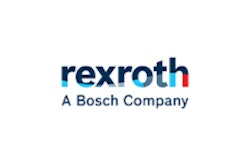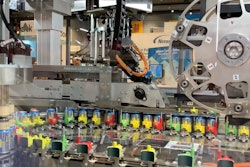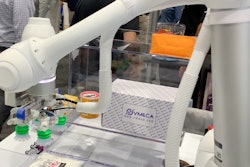Automation use in packaging and processing continues to explode, with CPGs looking to improve operations while also coping with a labor shortage. On this episode of unPACKed with PMMI, Sean Spees from Bosch Rexroth joins us to discuss what CPGs should ask from automation suppliers to keep up with shifting consumer demands and, with that, how they can adapt their packaging and packaging lines to stay flexible and nimble to keep up with all the changes. Automation implemented today will need to evolve as a company's needs evolve.
To subscribe, rate, review, and find more unPACKED podcast episodes, visit pmmi.org/podcast or find us on Apple podcasts, Spotify, iHeart Radio or wherever you listen to your podcasts.
 | Read the full transcript below.
|
Sean Riley:
So with all the fancy introductions out of the way, welcome to the podcast, Sean.
Sean Spees:
Good morning. How are we doing?
Sean Riley:
We're doing good. And I'm glad to have... We'll confuse some listeners out there with two Seans who, as you noted when we were talking earlier, both spell it the correct way. So I guess to kick things off, I know a little bit about you guys, but I think you could give us a little background on Bosch Rexroth and your role there so that people know exactly whom they're listening to.
Sean Spees:
So, my role at the company is market segment manager for consumer package goods. So it's a relatively new role within the company. So we are strategy strategically broken up into segments. Some of my counterparts are electric vehicles, batteries, semiconductors, and warehouse automation. And then my group is the consumer package goods. So we're building a team to service our end users and OEMs out in the marketplace.
Sean Riley:
Interesting. And that's a huge topic that we've covered because the consumers are driving a lot of the changes and a lot of the challenges that everybody is facing in our marketplace. So I guess, what are some of the challenges that you are seeing in your role that CPGs are grappling with is they're trying to keep up with all these shifting consumer demands and, with that, how they can adapt their packaging and vis a vis that their packaging lines to stay flexible and nimble to keep up with it.
Sean Spees:
Yeah, it's a great question. And the challenges that I've seen in my career, one is space. Okay. And when you look at factory automation, space is always the one thing that is the last thought of when you're putting the line together. It's always making the product first. And then, when you look at the secondary or tertiary packaging side, there seem to be issues. So there are always space constraints. There's always the labor side of it. So when you look at labor today, as far as the current workforce, we're getting what's called the silver tsunami that's happening now, where we're getting the baby boomer era and are starting to retire. So we're having the next generation of operators and maintenance folks coming into play. That's creating some challenges, finding that labor is another challenge and then really supporting when you look internally and externally.
When you look at it, especially from an end user perspective, the folks in the engineering departments and maintenance and production are wearing many hats and are spread thin. So even internally, it's hard to support projects, to be honest. So they're also looking for partners out there that can take these responsibilities of the line design, that can take integration responsibilities and help them out. But the external side of it is you got to find those folks out there that can support, support production line, support parts, and have technicians available. So those are some of the main challenges there. And at the end of the day, multiple SKUs are coming out.
So in consumer package goods, it's smaller, we're looking at the eCommerce side of the business now where folks want to order one or two things versus 10, and it has to be packaged in a certain way. Okay. So when you look at the flexibility of, let's say, packaging machinery, there's only so many, so small or so big, spec-wise, that these machines can handle. So, as you said earlier, the consumers are driving this. They want what they want, and the OEMs and end users must find a way to deliver.
Sean Riley:
Yeah. And I guess from your standpoint, or from the perspective of the CPGs, when you're looking at all these different ways to try and improve things or enhance flexibility on your lines, are there places, low-hanging fruit that the companies can target that might be ripe for improvement, or areas that they can improve that'll be easier than others?
Sean Spees:
Yeah, absolutely. So, the first item is changeover and ease of use when you look at overall flexibility, when we're changing over from different products or different sizes, from the OEM side of the business, the customers or the end user, let's say the customer being the end user, they want it quick. They need more time to do an eight-hour changeover for a different product. So any time that can be saved to change over to a different outcome will only help their production numbers and get more products out the door, which will help profitability. So, when you look at other drives and motors that are out there, they've got to be minor, they have to be adequate to fit within these specific machines, but the customer, the end user operators, just at the end of the day, they want to push a button. That's how easy they want it, is-.
Sean Riley:
Yeah, exactly.
Sean Spees:
... to push it and have the machine change over itself. So, flexibility and changeover is a definite need and want. When you look at the redirection of labor mentioned earlier, many operators and production folks are doing jobs that robots can do today. Not necessarily saying we want to eliminate labor, but there's a way to redirect it. Okay. And they can go do something else within the plant to make it more productive. And that's where the robotics and autonomous mobile robotics for one come into play when you're looking at transporting pallets, for instance, from the end of a production line to the bay doors, the dock doors for loading. Okay, some robots can do that now that are very simple to program. You look at collaborative robotics.
So collaborative robotic is a robot you can actually work next to, okay, where you don't need fencing and guarding around it, which again takes up space. Operators can walk within certain distances, or if they bump into it, the robot stops. It doesn't cause injury, which is nice. So they can do various activities such as case packing. They can do activities such as palletizing if the cases are lightweight and the line speeds are slow enough. So again, you don't have to have a person at the end of the line picking up a four-pound box for an eight-hour shift, which could cause ergonomic issues, which then you've got workman's comp, and you've got some other items there.
So, there are ways to do that, from a labor perspective, to redirect, and then from a safety perspective, to have a more productive facility. And then the other item we're seeing a push in right now is mixed pallets in variety packs. Okay. And going back to the consumer, if you look at beverages, for instance, there are different sodas and carbonated soft drinks and seltzers and everything else, and nobody wants the same flavor, everybody wants a different taste. They want three different flavors. So again, that has to come off a line, the production line has to be grouped into these certain flavors and packaged. So that's another upstream process that somebody has to do to get to the consumer, same thing with whether it's a food product or personal care product. Those are the demands that production lines have to be flexible on to produce one type of product or to produce multiple that go basically in the same container.
Sean Riley:
Very interesting. So you've touched on a bunch of developments in automation that will help CPGs. Are there any that we haven't touched on yet that we might have missed that will help them overcome the challenges to keep things flexible beyond, you talked about cobots, you talked about a different ways to move operators off the line into better positions. Are there other things that will help make the lines even more flexible?
Sean Spees:
Yeah, from a new development standpoint in the last several years, smaller componentry is one. Okay. Let me go back to space again, that there are ways to reduce your overall footprint of your current machines, there are ways to reduce electrical panel space depending on the type of equipment that's on the line, the electrical panel can take up a large portion of that line, okay, which could take up walkway space, or just general area in the plant. Okay. So there are ways to reduce the overall panel space with smaller drives and motors. So again, smaller componentry and almost going cabinet-less, or panel-less, the improvement in robotics. When you look at the ease of use, for instance, we're talking about the cobots, the collaborative robots.
A simple Galaxy Note touchpad or an iPad can program these. So the operators don't have to go to robotics programming school, where you don't have to hire somebody with a robotics programming background to run the line. It's very simple with these, or it's a plug-and-play type mentality; the autonomous mobile robots can carry heavier loads up to one-ton capacity. When you look at linear motion, linear servo platforms, and one for product handling, you can get more flexibility out of your product transfers. Okay, or, for instance, when we look at flow wrap products at high speed, you might be limited to the parameters of certain product transfers, a linear motion servo platform is more of a magnetic type application where it's on demand. Okay.
So when products are coming out at high speed, these products can... When you have a, basically, asynchronous to a synchronous process, you're not limited to just being handcuffed to the size parameters of a machine, it's a lot more flexible that way, if that makes sense any sense, but another main point is open architecture. What I mean by that is that it's from a control standpoint. And when I mentioned earlier, as far as the workforce and those that have been in the plan environments for the last 30, 40 years, they've known a certain type of controls platform. And whether it's here in the US or Europe, there are different platforms. And some of them are very specific in how they operate.
When we look at open architecture, there's technology now that's here today and shortly where it's going to be like a smartphone. We love to grab our cell phones, and we can push apps if we want to order food, if we want to connect with our friends, you name it. Everything's in an app now. What if the whole control of the line was the same way? Okay. Where you could walk up to a machine and simply through, again, whether it's an iPad, or a notepad, or whatever it is, then an operator can just through a URL, download an app and be able to extract the data that's needed or troubleshooting, or tie in all the pieces of the line, simply through an app-based and cloud-based type platform. So, that's where technology is moving today and is very exciting.
Sean Riley:
Yeah. And that's something that when we always talk about the... We're an industry struggling to maintain a workforce, and to upskill is a word that we hear a lot about upskilling the workforce. This is something that always pops up where we now have a generation coming into the force, or that's already here that is so used to and comfortable with things like smartphones and iPads and things like that. So there isn't really, it's less of a learning curve for the workforce now than it would be for previous generations because these are things they use daily, as you said. So having something as simple as an app-based platform is something that these new workers have used since they were kids. So that would, yeah, make it a much more flexible line for people to use.
And I know we touched on some of the material handling parts of it, but I know that's such a big part of the packaging. So what are some developments in the area that people can use to improve their flexibility there? Because that can be labor... You even mentioned picking up the four-pound box for eight hours; that's such a labor-intensive type of thing or just a repetitive type of thing that doesn't need a human to do necessarily anymore if we can find better opportunities for the human to move into a different part of the workforce. So are there any other things in that aspect that would improve flexibility?
Sean Spees:
Yeah. When you look at the material on the handling side, conveyors might be viewed as a simple commodity at the end of the day. Okay. Many manufacturers make them, but when you look at getting your products from point A to point Z, there are a lot of obstacles, twists and turns, whether or not certain belt conveyor belt types have to be maybe friction or depending on the product, you don't want to damage graphics, okay, when you look at cosmetics or specific items in personal care, you have to be very careful of how you handle it.
So one, the flexibility to be able to provide different types of conveyor, which we call conveyor chain or plastic-type chain conveyor, mainly in the CPG from the product handling side, you have to have a different variety of offerings there for, again, when you look at CPG, it's a giant sandbox, I use a sandbox analogy, and there are many toys in this sandbox in consumer package goods now when you look at food, personal care beverage, even getting into automotive parts or over the counter pharmaceuticals, there's a lot to play with. But, when you look at the number of SKUs and sizes again, that's where auto adjustability or easy adjustability of these conveyor rails can be. Okay. When you have to go from 65 millimeters to 120 millimeters, let's say, or whatever that case may be, again, going back to the changeover, where we talked auto changeover, is there a way to electrify that? There is.
We can electrify and put motors on these changeover parts, making it easier, or pneumatic, or however it is, but there are options there that we're able to provide today that can give the end user a little bit more comfort in, again, that overall line changeover and more uptime.
Sean Riley:
Very interesting. So with all of these changes and the advances we've touched on during this discussion, let's say someone is coming to you. What one piece or couple pieces of advice do you have for CPGs that are working with automation or entering into automation or have had automation in the past but are trying to improve their flexibility? With all these changes, what advice do you give them to help them work with their supplier?
Sean Spees:
Great question. Yeah. So what we're seeing right now is either revamping existing production lines and how they can improve efficiencies there, or when you look at Greenfield projects, a lot more green fields are also happening. Latin, more plants are being built. So when you look at the overall design of the lines, how can it be more efficient, and how can you grow from year to year and not be pigeonholed or trapped into-.
Sean Riley:
Yeah. Boxed in.
Sean Spees:
... line space? So, I suggest finding a company that can provide several pieces of the puzzle. A company that we buy from people we trust and companies that are well established that have that product depth won the product depth. Still, the knowledge, the engineering and technical resources to support it, because at the end of the day, the installation is about, and I've heard this term a few different ways. Still, about 80% of the project's overall cost is recognized after installation. So you have the concept upfront, but once it's installed, it's the support that keeps that line running and the longevity, and that's where you see your return. So, it's just finding that company that can provide all of those factors to integrate a successful production line.
Sean Riley:
Well, that sounds awesome. So I can't thank you enough, Sean, for taking time out of your day. You're very busy with all the things you have going on, on your end to come on here and share some of this information that we can share with the listeners to help them during this very, what's the word? Busy time is when things are changing rapidly, and people need to be flexible. Thank you again, Sean, for coming on the podcast with us.
Sean Spees:
Oh, pleasure is all mine. I appreciate the opportunity, and it's been great.


























